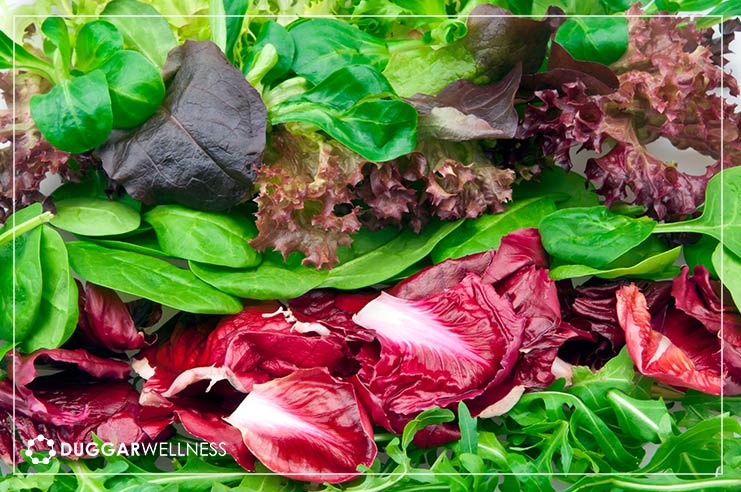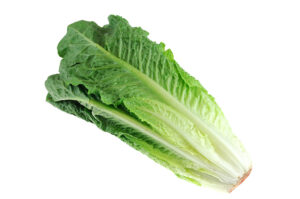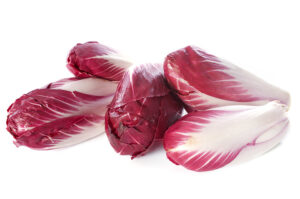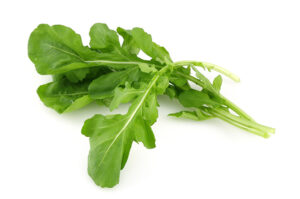Whether you sneak leafy greens into a smoothie or pile them in a bowl to create the perfect salad, leafy greens offer loads of benefits. Here’s how they keep you healthy:
Vitamins and Minerals
Leafy greens are extremely high in a variety of vitamins and minerals, including the following.
Vitamin K
Can help prevent osteoporosis and inflammatory diseases.
Vitamin A
Plays an important role in vision, bone growth, reproduction, cellular function, and immunity.
Vitamin E
Is important for immune and metabolic processes.
Vitamin C
Promotes healing, helps the body absorb iron, and plays an important role in the health of skin, bones, and connective tissue.
Magnesium
Decreases risk of developing type 2 diabetes and osteoporosis and can reduce the frequency of migraines and lower blood pressure.
Potassium
Plays an important role in the function of every cell in the body. Is involved with heart function and muscle contraction. May help prevent osteoporosis.
Calcium
Is important for bone health. Could potentially protect from cardiovascular disease and cancer, although research is inconclusive.
Fiber
Leafy greens are not only high in important vitamins and minerals: They can also help you reach your recommended daily intake of fiber, approximately 38 grams per day for men and approximately 25 grams per day for women. For reference, one cup of spinach provides 0.7 grams of fiber, and one cup of romaine.
Fiber helps:
o Protect against cardiovascular disease
o Helps to control blood sugar
o Helps support normal bowel movements.
o Control appetite by helping you feel full faster and longer
o To reduce the recurrence and the prevention of a number of cancers.
Fiber is also critical to feeding your gut microbes. If you don’t get enough fiber, some microbes can die and others can eat https://www.ncbi.nlm.nih.gov/pubmed/23426893 the mucus lining in your stomach.
When the bacteria in your digestive tract metabolize fiber, they produce short chain fatty acids, which may help:
o Reduce inflammation
o Enhance immunity
o Inhibit fat accumulation
Phytonutrients
Phytonutrients are compounds found in leafy greens (along with other vegetables and fruits) these include carotenoids and flavonoids. Carotenoids and flavonoids are responsible for the pigments that give fruits and veggies their vibrant colors. They act as antioxidants and have strong cancer fighting properties.
Chlorophyll
Chlorophyll is the term for several green pigments that are found in plants. Chlorophyll plays a vital role in plant photosynthesis (during which plants absorb energy from light), and it also may provide the following benefits to health:
o Accelerate wound healing
o Help prevent cancer
o Detoxify the liver
o Boost the immune system
o Help treat anemia
Because the type and amount of nutrients vary within each leafy green, it’s important to consistently rotate through a variety of them to make sure you’re exposing yourself to the wide spectrum of their health benefits.
If the reasons above aren’t enough to convince you to eat leafy greens every day. A recent study in Neurology, the American Academy of Neurology’s medical journal, showing that eating salads daily could keep your brain younger and low memory decline may be better motivation.
This study analyzed the diets and brain activity of nearly 1,000 participants with an average age of 81 and tracked these patients for about 5 years. Each year the participants answered a questionnaire each year. This questionnaire asked how many servings of leafy greens they ate daily as well as a memory skills test.
Over the course of the study, all participants showed a gradual decline in memory and thinking skills, but those who ate 1.3 servings showed a much slower rate of decline than those who ate only about 0.1 servings per day. The difference translates to being 11 years younger in age.
10 Favorite Leafy Greens
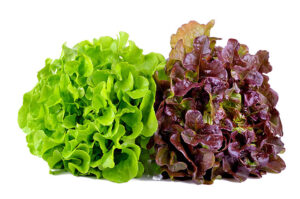
Red & Green Leaf Lettuce
They have a mild flavor and are very pliable, despite the crunchy stem. Their uneven ruffled surfaces add layers of texture to salads. Because the leaves are so large, it’s best to tear them up into bite-size pieces. Leaf lettuce is a great source of Vitamin A, K and C.
Texture & Taste Profile:
Flavorful green, red-tipped or red-speckled leaves.

Spinach
Tied with kale as the most nutritious of all the greens, it delivers more than a dozen flavonoids (anti-inflammatory and cancer-fighting compounds) and half the recommended dose of vision-maintaining vitamin A in one ½-cup serving. Eat it morning (in an omelet or a smoothie), noon (in a salad or a wrap), and night (any way you can imagine).
Texture & Taste Profile:
Tender leaves with an earthy, buttery-to-bitter flavor.

Kale
This curly green offers a pleasing, almost crunchy texture, and is packed with nutrients, including vitamin A and C, calcium, and potassium. Kale comes in several varieties including curly kale, dino kale, and redbor kale. (Cut out the tough center stem.
Texture & Taste Profile:
Crinkled, deep green to purple leaves; mild cabbage flavor.
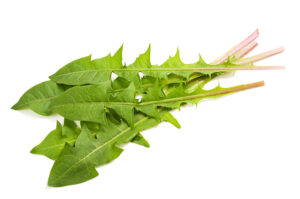
Dandelion
Dandelion greens have a fairly sharp flavor, similar to arugula in texture and size. Dandelion greens are best in a simply dressed salad with light toppings to avoid weighing down the tender leaves. If you find these greens too bitter to use in a simple salad, try adding them to your next green smoothie for a spicy boost! Dandelion greens have more vitamin A than any food except cod liver oil and beef liver! They are also rich in calcium, potassium, vitamin K and fiber.
Texture & Taste Profile:
Narrow, jagged, bitter greens; small, young leaves best
Romaine
This large leafy lettuce is stiffer than most; a thick center rib gives it a real crunch. The rib also gives this lettuce a slightly bitter taste. There’s a reason that romaine is so popular: its sturdy, crisp leaves have a fresh, clean taste that provides a neutral base for all the salads (all of them). If you’re not in the mood for a salad, use these leaves for lettuce wrapping your favorite sandwich ingredients. Romaine is high in minerals such as calcium, phosphorous, magnesium, and potassium. Romaine also is packed with Vitamins C and K.
Texture & Taste Profile:
Crunchy, ruffled green leaves; slightly bitter.
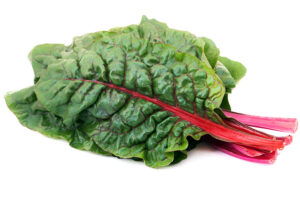
Swiss Chard
Featuring wavy, wrinkled leaves and colorful fibrous stems, Swiss chard can add color sweetness to grain dishes like a pilaf, add to an omelet or frittata. (The stems need extra cooking time, so chop them up and add them to the pan a few minutes before the leaves). This nutritional powerhouse contains high levels of vitamins A and C and magnesium.
Texture & Taste Profile:
Earthy and salty, slightly sweet stems.
Radicchio
Pronounced “rah-dick-ee-yo,” also known as red chicory, red leaf chicory, red Italian chicory. You can find this deep-red-purple vegetable sold either as a compact round head, as pictured above, or shaped like its relative, endive. Radicchio is abundant in vitamin C, A, K, and E, it is also a good source of potassium and calcium. The bright coloring makes it stand out. When cooked, the red-purple hue turns brown and what was once bitter becomes sweet.
Texture & Taste Profile:
Crunchy, dark red and white leaves with bitter bite; ‘Treviso’ has sweet undertones.
Arugula
This leafy green is actually closely related to kale and cauliflower. Its strong flavor and aroma make it a staple in Mediterranean and Italian cooking. Arugula is a great source of folate and calcium and an excellent source of Vitamin A and C.
Texture & Taste Profile:
Tender, peppery, slightly bitter.
Bok Choy
Bok choy is part of the cruciferous family of vegetables, which have been shown to prevent cancer. It is also one of the top anti-inflammatory foods. Bok choy is rich in Vitamins A, K, and C and is rich in iron, calcium. phosphorus and magnesium.
Texture & Taste Profile:
Juicy leaves with crisp stems; mild, sweet, and slightly peppery flavor.
Spring Mix
Otherwise known as mesclun, a French word meaning “mixture.” This mix is a potpourri of small young tender leaf greens. Traditionally this mix contains, chervil, arugula, spinach, frisee, oak leaf, and radicchio. Because spring mix consists of young leaves they have a higher concentration of chlorophyll which strengthens our red blood cells, improves oxygen supply, and helps eliminate free radicals from the body.
Texture & Taste Profile:
Subtly sweet and tender.
Add more green to your life by creating some delicious salads.
Greens & Grapefruit Salad
Tropical Fajita Salad
Salads-in-a-Jar
Create your own, using these great salad ingredients:
- Fresh fruit, such as sliced pears, apples, cherries, grapes, berries, or citrus sections
- Dried fruit, such as dried cherries, cranberries, apricots, raisins, and figs
- Onions, especially thinly sliced green onions or red onions
- Shredded or thinly sliced carrots
- Sprouts, broccoli, mung bean, sunflower, radish, etc.
- Quartered and sliced zucchini, yellow squash, and cucumbers
- Sliced red or green sweet peppers or roasted red peppers
- Chopped tomatoes or halved cherry or grape tomatoes
- Pitted sliced green or black olives
- Sliced or chopped avocado
- Sliced mushrooms
- Sliced or chopped hard-cooked eggs
- Cooked beets
- Toasted nuts, such as almonds, walnuts, pecans, or pine nuts
- Cheese, such as crumbled blue cheese, goat cheese, or feta
- Crumbled bacon slices
- Diced or chopped cooked chicken, steak or turkey
 160 N Main, Bountiful, UT 84010
160 N Main, Bountiful, UT 84010  801-677-7878
801-677-7878
